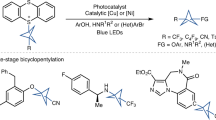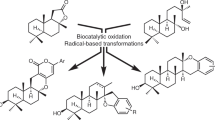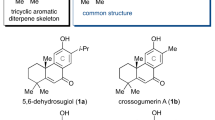Abstract
Among the frontier challenges in chemistry in the twenty-first century are the interconnected goals of increasing synthetic efficiency and diversity in the construction of complex molecules. Oxidation reactions of C–H bonds, particularly when applied at late stages of complex molecule syntheses, hold special promise for achieving both these goals. Here we report a late-stage C–H oxidation strategy in the total synthesis of 6-deoxyerythronolide B (6-dEB), the aglycone precursor to the erythromycin antibiotics. An advanced intermediate is cyclized to give the 14-membered macrocyclic core of 6-dEB using a late-stage (step 19 of 22) C–H oxidative macrolactonization reaction that proceeds with high regio-, chemo- and diastereoselectivity (>40:1). A chelate-controlled model for macrolactonization predicted the stereochemical outcome of C–O bond formation and guided the discovery of conditions for synthesizing the first diastereomeric 13-epi-6-dEB precursor. Overall, this C–H oxidation strategy affords a highly efficient and stereochemically versatile synthesis of the erythromycin core.
This is a preview of subscription content, access via your institution
Access options
Subscribe to this journal
Receive 12 print issues and online access
$259.00 per year
only $21.58 per issue
Buy this article
- Purchase on Springer Link
- Instant access to full article PDF
Prices may be subject to local taxes which are calculated during checkout




Similar content being viewed by others
References
Fraunhoffer, K. J., Bachovchin, D. A. & White, M. C. Hydrocarbon oxidation vs. C–C bond-forming approaches for efficient synthesis of oxygenated molecules. Org. Lett. 7, 223–226 (2005).
Chen, M. S. & White, M. C. A predictably selective aliphatic C–H oxidation reaction for complex molecule synthesis. Science 318, 783–787 (2007).
Das, S., Incarvito, C. D., Crabtree, R. H. & Brudvig, G. W. Molecular recognition in the selective oxygenation of saturated C–H bonds by a dimanganese catalyst. Science 312, 1941–1943 (2006).
Yang, J., Gabriele, B., Belvedere, S., Huang, Y. & Breslow, R. Catalytic oxidations of steroid substrates by artificial cytochrome P-450 enzymes. J. Org. Chem. 67, 5057–5067 (2002).
Wender, P. A., Hilinski, M. K. & Mayweg, A. V. W. Late-stage intermolecular C–H activation for lead diversification: a highly chemoselective oxyfunctionalization of the C-9 position of potent bryostatin analogues. Org. Lett. 7, 79–82 (2005).
Nicolaou, K. C. et al. Total synthesis of taxol. Nature 367, 630–634 (1994).
Wender, P. A. et al. The first synthesis of a daphnane diterpene: the enantiocontrolled total synthesis of (+)-resiniferatoxin. J. Am. Chem. Soc. 119, 12976–12977 (1997).
Hinman, A. & Du Bois, J. A stereoselective synthesis of (–)-tetrodotoxin. J. Am. Chem. Soc. 125, 11510–11511 (2003).
Davies, H. M. L., Dai, X. & Long, M. S. Combined C–H activation/Cope rearrangement as a strategic reaction in organic synthesis: total synthesis of (–)-colombiasin A and (–)-elisapterosin B. J. Am. Chem. Soc. 128, 2485–2490 (2006).
Paterson, I. & Mansuri, M. M. Recent developments in the total synthesis of macrolide antibiotics. Tetrahedron 41, 3569–3624 (1985).
Paterson, I. & Rawson, D. J. Studies in macrolide synthesis: a highly stereoselective synthesis of (+)-(9S)-dihydroerythronolide A using macrocyclic stereocontrol. Tetrahedron Lett. 30, 7463–7466 (1989).
Corey, E. J. et al. Total synthesis of erythromycins. 4. Total synthesis of erythronolide B. J. Am. Chem. Soc. 100, 4620–4622 (1978).
Woodward, R. B. et al. Asymmetric total synthesis of erythromycin. 1. Synthesis of an erythronolide A seco acid derivative via asymmetric induction. J. Am. Chem. Soc. 103, 3210–3213 (1981).
Breton, P. et al. Total synthesis of erythromycin B. Tetrahedron 63, 5709–5729 (2007).
Masamune, S., Hirama, M., Mori, S., Ali, S. A. & Garvey, D. S. Total synthesis of 6-deoxyerythronolide B. J. Am. Chem. Soc. 103, 1568–1571 (1981).
Myles, D. C., Danishefsky, S. J. & Schulte, G. Development of a fully synthetic stereoselective route to 6-deoxyerythronolide B by reiterative applications of the Lewis Acid catalyzed diene aldehyde cyclocondensation reaction: a remarkable instance of diastereofacial selectivity. J. Org. Chem. 55, 1636–1648 (1990).
Evans, D. A., Kim, A. S., Metternich, R. & Novack, V. J. General strategies toward the syntheses of macrolide antibiotics. The total syntheses of 6-deoxyerythronolide B and oleandolide. J. Am. Chem. Soc. 120, 5921–5942 (1998).
Crimmons, M. T. & Slade, D. J. Formal synthesis of 6-deoxyerythronolide B. Org. Lett. 8, 2191–2194 (2006).
Staunton, J. & Wilkinson, B. Biosynthesis of erythromycin and rapamycin. Chem. Rev. 97, 2611–2629 (1997).
Celmer, W. D. Stereochemical problems in macrolide antibiotics. Pure Appl. Chem. 28, 413–453 (1971).
Corey, E. J. & Cheng, X. M. The Logic of Chemical Synthesis (Wiley, 1995).
Fraunhoffer, K. J., Prabagaran, N., Sirois, L. E. & White, M. C. Macrolactonization via hydrocarbon oxidation. J. Am. Chem. Soc. 128, 9032–9033 (2006).
Myers, A. G. et al. Pseudoephedrine as a practical chiral auxiliary for the synthesis of highly enantiomerically enriched carboxylic acids, alcohols, aldehydes, and ketones. J. Am. Chem. Soc. 119, 6496–6511 (1997).
Evans, D. A., Bartroli, J. & Shih, T. L. Enantioselective aldol condensations. 2. Erythro-selective chiral aldol condensations via boron enolates. J. Am. Chem. Soc. 103, 2127–2129 (1981).
Stork, G. & Rychnovsky, S. D. Concise total synthesis of (+)-(9S)-dihydroerythronolide A. J. Am. Chem. Soc. 109, 1565–1567 (1987).
Evans, D. A. et al. Enantioselective Michael reactions. Diastereoselective reactions of chlorotitanium enolates of chiral N-acyloxazolidinones with representative electrophilic olefins. J. Org. Chem. 56, 5750–5752 (1991).
Bäckvall, J.-E., Byström, S. E. & Nordberg, R. E. Stereo- and regioselective palladium-catalyzed 1,4-diacetoxylation of 1,3-dienes. J. Org. Chem. 49, 4619–4631 (1984).
Burckhardt, U., Baumann, M. & Togni, A. A remarkable anion effect on the enantioselectivity of the Pd-catalyzed allylic amination using ferrocenyl ligands. Tetrahedron Asymmetry 8, 155–159 (1997).
Inanaga, J., Hirata, K., Saeki, H., Katsuki, T. & Yamaguchi, M. A rapid esterification by means of mixed anhydride and its application to large-ring lactonization. Bull. Chem. Soc. Jpn 52, 1989–1993 (1979).
Fischbach, M. A. & Walsh, C. T. Assembly-line enzymology for polyketide and nonribosomal peptide antibiotics: logic, machinery, and mechanisms. Chem. Rev. 106, 3468–3496 (2006).
Castonguay, R., He, W., Chen, A. Y., Khosla, C. & Cane, D. E. Stereospecificity of ketoreductase domains of the 6-deoxyerythronolide B synthase. J. Am. Chem. Soc. 129, 13758–13769 (2007).
Katz, L. & Ashley, G. W. Translation and protein synthesis: macrolides. Chem. Rev. 105, 499–527 (2005).
Burke, M. D. & Schreiber, S. L. A planning strategy for diversity-oriented synthesis. Angew. Chem. Int. Ed. 43, 46–58 (2004).
Balskus, E.P. & Jacobsen, E. N. Asymmetric catalysis of the transannular Diels–Alder reaction. Science 317, 1736–1740 (2007).
Lewis, C. A. & Miller, S. J. Site-selective derivatization and remodeling of erythromycin A by using simple peptide-based chiral catalysts. Angew. Chem. Int. Ed. 45, 5616–5619 (2006).
Acknowledgements
Financial support was provided by the National Institutes of Health/National Institute of General Medicine (grant no. GM076153), Eli Lilly, Bristol-Myers Squibb, Pfizer and Amgen. E.M.S. is the recipient of a R. C. Fuson graduate fellowship, Pfizer graduate fellowship and the Roche Excellence in Chemistry Award. We thank Professor Jerome Baudry for assisting with the molecular modelling studies, D. J. Covell for his insight into π-allyl-Pd fluoride complexes and I. Patterson and P. B. Dervan for discussions.
Author information
Authors and Affiliations
Contributions
E.M.S. and M.C.W. conceived and designed the experiments, E.M.S. performed the experiments and E.M.S. and M.C.W. co-wrote the paper.
Corresponding author
Supplementary information
Supplementary information
Supplementary information (PDF 1932 kb)
Supplementary information
Supplementary information (PDF 4697 kb)
Supplementary information
Crystallographic information for compound 13 (CIF 27 kb)
Rights and permissions
About this article
Cite this article
Stang, E., Christina White, M. Total synthesis and study of 6-deoxyerythronolide B by late-stage C–H oxidation. Nature Chem 1, 547–551 (2009). https://doi.org/10.1038/nchem.351
Received:
Accepted:
Published:
Issue Date:
DOI: https://doi.org/10.1038/nchem.351
This article is cited by
-
Regio- and stereodivergent antibiotic oxidative carbocyclizations catalysed by Rieske oxygenase-like enzymes
Nature Chemistry (2011)
-
Expanding the art of synthesis
Nature Chemistry (2009)



